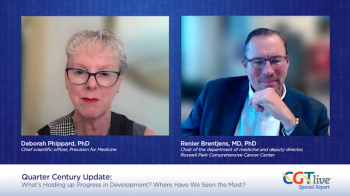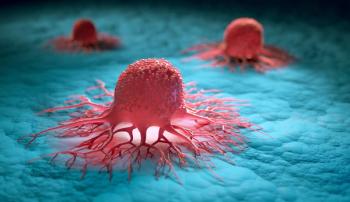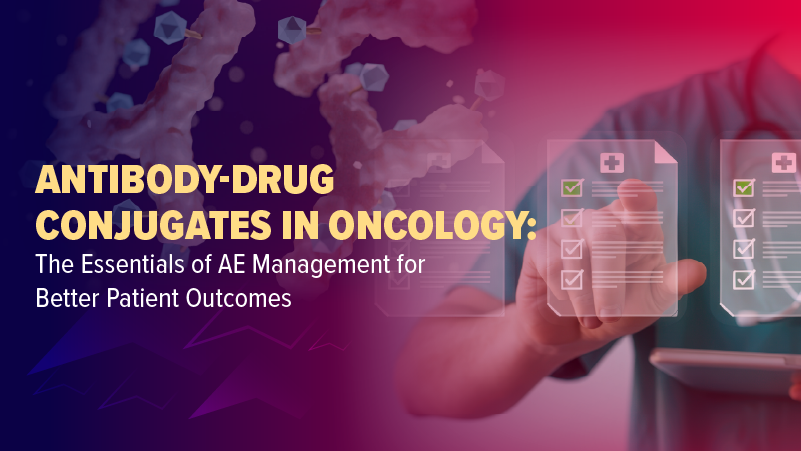
New Investigations Question Need for Cisplatin in Advanced Non–Small-Cell Lung Cancer
AMSTERDAM, The Netherlands-Cisplatin (Platinol), the cornerstone of chemotherapy for advanced non–small-cell lung cancer (NSCLC), continues to come under increased scrutiny, noted Pieter E. Postmus, MD, FCCP. Investigators are searching for chemotherapeutic strategies that are as effective as platinum-based therapy, but are better tolerated and more cost-effective, he explained. Dr. Postmus is with the Department of Pulmonology, Vrije Universiteit, University Hospital, in Amsterdam, The Netherlands.
AMSTERDAM, The NetherlandsCisplatin (Platinol), the cornerstone of chemotherapy for advanced nonsmall-cell lung cancer (NSCLC), continues to come under increased scrutiny, noted Pieter E. Postmus, MD, FCCP. Investigators are searching for chemotherapeutic strategies that are as effective as platinum-based therapy, but are better tolerated and more cost-effective, he explained. Dr. Postmus is with the Department of Pulmonology, Vrije Universiteit, University Hospital, in Amsterdam, The Netherlands.
Despite the fact that efficacy was demonstrated for many drugs and combinations, many physicians are still not convinced about the optimal regimen, Dr. Postmus said.
That much is very clear from the design of the European Organization for Research and Treatment of Cancer (EORTC) 08975 trial comparing the non-platinum doublet gemcitabine (Gemzar)/paclitaxel (Taxol) with gemcitabine/cisplatin and paclitaxel/cisplatin. Dr. Postmus outlined the rationale and design of this trial, which recently completed accrual.
Survival Benefit Seen
Despite its considerable acute and chronic toxicity, cisplatin was the drug that was used in all combinations demonstrating survival benefit if comparing chemotherapy vs best supportive care in advanced NSCLC, Dr. Postmus noted. Prior to the introduction of cisplatin-based chemotherapy, the efficacy of chemotherapy in disseminated NSCLC was marginal and unpredictable, with some patients seeming to benefit, while others did not.
In contrast, a large meta-analysis showed that patients treated with cisplatin-based chemotherapy and best supportive care had a prognosis modestly but significantly better than best supportive care alone. Median survival improved by 6 weeks and the 1-year survival rate was 10% higher.
The next step was to try cisplatin in combination with the various newer chemotherapeutic agents active in advanced NSCLC. These agents include the taxanes paclitaxel and docetaxel (Taxotere), the nucleoside analogue gemcitabine, the vinca alkaloid vinorelbine (Navelbine), and the topoisomerase-I inhibitor irinotecan (Camptosar).
All of these agents, by themselves, have been documented to produce response rates of 20% to 25% and 1-year survival rates of 30% to 40% for NSCLC, according to Dr. Postmus. The combination of these drugs and cisplatin in large phase III investigations has produced efficacy or tolerability generally superior to that achieved with older combinations, such as cisplatin/etoposide (VePesid).
Focus of Studies Shifts
More recently, the focus has shifted somewhat, from efficacy to questions of quality of life and cost effectiveness in studies comparing new platinum-based combinations with one another. These results are emerging in trials such as ECOG 1594, where four doublets were compared: paclitaxel/cisplatin, gemcitabine/cisplatin, docetaxel/cisplatin, and paclitaxel/carboplatin (Para-platin). Not much difference was seen at 1 year between these doublets in safety or efficacy, although the combination of gemcitabine/cisplatin had a significantly longer time to progression (P = .003).
Furthermore, new data presented at the World Conference on Lung Cancer revealed that overall survival at 2 years was numerically highest in the gemcitabine arm.
Gentler Doublets Developed
One major issue involving cisplatin is whether the drug is truly necessary for the treatment of advanced NSCLC in most patients over 70 years old, who frequently have impaired organ function.
A recent tack is to develop gentler doublets that might produce fewer side effects, thus making chemotherapy accessible to a much wider range of patients. EORTC 08975, for example, is a randomized phase III trial that looks at the nonplatinum combination of gemcitabine and paclitaxel vs cisplatin/gemcitabine and cis-platin/paclitaxel.
Treatment cycles in EORTC 08975 are every 3 weeks. Cisplatin is administered on day 1 at 80 mg/m². Paclitaxel is administered on day 1 at 175 mg/m² over 3 hours, while gemcitabine is administered on days 1 and 8 at 1,250 mg/m². Endpoints in this trial include not only survival and time to progression, but also quality of life.
The trial, closed in July 2000, included approximately 500 patients randomized to one of the three arms. A preliminary analysis of the data is expected sometime in the first half of 2001.
Dr. Postmus said there are several reasons for using gemcitabine/paclitaxel as the nonplatinum arm of this study. First, the combination has been shown to be not very toxic in phase I/II trials. Furthermore, activity has been demonstrated in phase II trials. Taken together, these findings suggest gemcitabine/paclitaxel might be feasible for administration in the outpatient setting.
Meanwhile, cisplatin is not the only platinum compound under scrutiny. Carboplatin has been shown to be better tolerated than cisplatin in many investigations. Even so, some researchers are convinced there could be better approaches within the realm of currently accepted chemotherapeutic agents. A recently launched Dutch trial is comparing the combination of carboplatin and docetaxel with docetaxel alone.
Even the role of carboplatin in combination chemotherapy is questioned, Dr. Postmus remarked.
Newsletter
Stay at the forefront of cutting-edge science with CGT—your direct line to expert insights, breakthrough data, and real-time coverage of the latest advancements in cell and gene therapy.












































